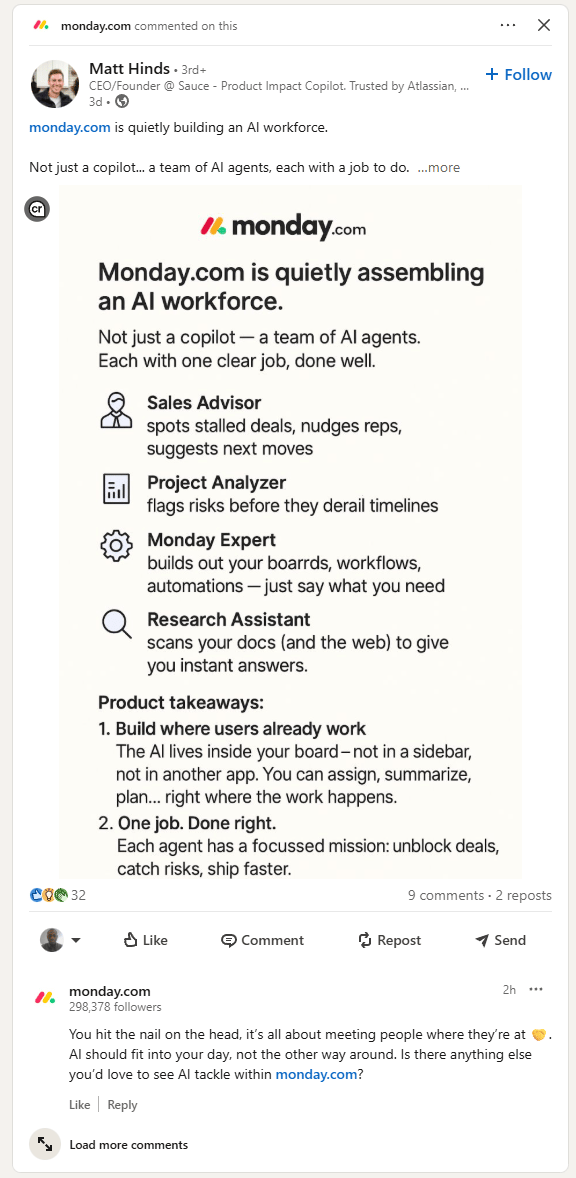- the analysis game
- Posts
- "Master of Ceremonies": The Final Reckoning.
"Master of Ceremonies": The Final Reckoning.
An AI-Powered Agile Platform Could Change Everything / Fail Spectacularly.

Using Master of Ceremonies by the Author.
After four posts exploring AI agents, interface design, and productivity promises, the last question - would investors actually back this?
The Case FOR Investment.
The concept isn't theoretical anymore. Atlassian has already shipped ceremony automation through 'Teamwork Collection' - agents that pull together summaries from Confluence pages and Jira tickets before meetings.
Early results show teams saving 4 hours per person per week, validating our 36-day annual recovery calculation. Customer HarperCollins is using it 'to great effect,' proving enterprise appetite exists.
But market opportunity alone doesn't guarantee success. What sets this apart from the dozens of AI productivity tools launching weekly? The 12-agent orchestration demonstrates genuine understanding of Agile complexity, based on years of BA experience across multiple industries. While competitors build single-point solutions, this is an entire AI workforce that understands team dynamics, project context, and ceremony nuances.
Strategic Partnership.
Atlassian is already building agents into Jira, looks like Monday.com aren’t far behind:

Screenshot from LinkedIn.
Dust, a two-year-old AI platform, hit $6 million ARR by building agents that complete business workflows rather than just chat. At €29 per user monthly, they prove enterprises pay for AI that takes action - creating GitHub issues, updating CRM records, and coordinating multiple agents.
The Technical Reality.
Building 12 coordinated AI agents isn't trivial. There's enterprise integrations with 8+ tools, security, compliance requirements and support.
Then there's the customer adoption uncertainty. Integration overhead could outweigh benefits. Cultural barriers to AI in collaborative settings are real.
The Critical Thinking Concern.
There's a deeper question about whether ceremony preparation "inefficiency" is actually valuable thinking time that shouldn't be automated away.
Teams might become overly dependent on AI-generated content, losing the reflective planning skills and adaptive problem-solving abilities, that manual preparation naturally develops.
The Validation Challenge.
We’re already using JIRA, Asana, Slack, Teams, Calendars and more to support delivery outcomes. The problem is visible in every sprint planning session where 30 minutes is spent gathering context from these tools.
How do you get independent validation without boring surveys that produce meaningless "yes, I'd totally use that" responses?
Real validation comes from operational deployment. Slack proved this when they partnered with companies like Cozy and Rdio to test integration capabilities in real enterprise environments before public launch. By March 2013, the company had a rough but functioning prototype that the team began using extensively.
“Master of Ceremonies” Validation Approaches:
Time-tracking experiments: Ask teams to track actual ceremony prep time for 2 weeks - possible, but outcomes are prioritised over experiments!
Money-on-the-table test: "Would you pay £xxx/month per team to save 2 hours weekly?"
Behaviour observation: Shadow teams during sprint planning - what do they actually struggle with? - ok, what about remote teams? privacy?
Tool abandonment analysis: Why did teams stop using Asana/Monday/Slack automation features?
Expense audit: What do teams currently spend on productivity tools that partially solve this?
Partnering with an Enterprise to build a bespoke prototype for their actual ceremonies, feels the better approach. If they won't invest time in testing with real workflows, they definitely won't pay for it.
Why this Approach works
The path forward requires:
A committed investor who understands that productivity gains compound over time
An enterprise partner who values team flow and efficiency over immediate cost savings
Focused execution on proving value before competitors respond
Targeting underserved markets with complex requirements
While Atlassian optimises for broad market appeal, a focused partnership solves one customer's exact workflow challenges perfectly. Enterprise partners get a solution tailored to their exact needs, in exchange for deep domain validation and a reference customer, that proves the concept works in real environments.
Potential Opportunities
Government procurement represents a massive opportunity - UK departments can spend £750k on agile projects
Regulated industries like pharmaceuticals (projected $16.49B AI market by 2034), and
Financial services where AI adoption remains cautious beyond basic automation.
Funding Questions
The questions that matter aren't rhetorical:
Will teams actually adopt AI ceremony prep, or just say they will?
Can massive value be proven for one enterprise before competitors respond?
Which enterprise values flow and productivity over immediate cost savings?
Is this a vitamin (nice-to-have) or painkiller (must-have)?
Are we building an AI tool or a productivity platform?
Who's the actual buyer: Agile coaches, Engineering managers, or CTOs?
What's our brand personality and how do we reach engineering teams?
What This Analysis Reveals.
✅ Market opportunity is real: USD 40 billion market, 97% Agile adoption
✅ Technical precedent exists: GitHub Copilot proves business AI adoption
✅ Problem is genuine: Ceremony preparation overhead is measurable
✅ Validation exists: Atlassian proves enterprise adoption
⚠️ Differentiation gap: How to compete with platform players already shipping
⚠️ Competition risk: Established players could build this quickly - Monday.com
⚠️ Execution complexity: How much would it cost to prove the concept works for a single ceremony!
This sits somewhere between "compelling opportunity" and " an expensive learning experience." The fundamentals are sound, but the execution risks are substantial.
The Bottom Line.
Maybe the real insight isn't to build "Master of Ceremonies", but whether the current ceremony preparation pain point, is actually worth solving with dedicated AI, or if it's better addressed by improving existing tools.
On reflection
I'm not ready to write this off as a LinkedIn thought experiment. But there’s also the 90% failure rate.
The difference lies in finding an enterprise partner willing to bet on productivity gains. Because in the end, this isn't about building the perfect AI platform - it's about proving that AI-powered ceremony preparation creates genuine competitive advantage.
Would you let an AI generate your next sprint planning agenda if it included data-driven insights about team capacity and historical velocity?
The gap between 'this sounds useful' and 'I'd actually use this in my team ceremony' might be where this concept lives or dies.
And that's a hypothesis worth testing.
Reply